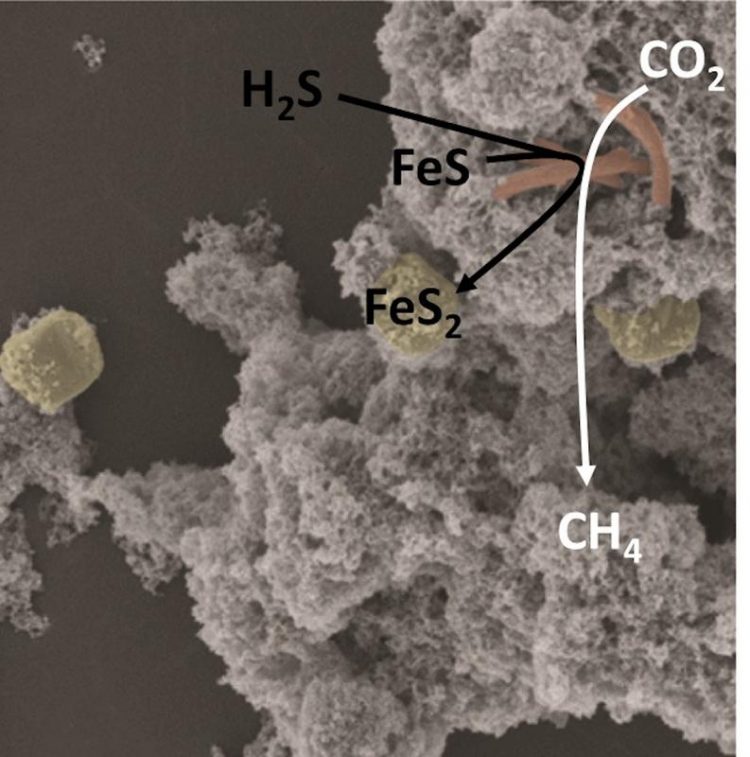Discovery of a Primordial Metabolism in Microbes

Electron microscopy image of a pyrite forming culture enriched from a wastewater treatment plant. Microbial cells are highlighted in red and pyrite crystals in yellow. DSMZ/Prof. Dr. Michael Pester
Microorganisms are well known to grow at the expense of almost any chemical reaction if it can deliver a small fraction of the cell internal “energy currency “ATP. Now, a team of German environmental microbiologists from the Leibniz Institute DSMZ–German Collection of Microorganisms and Cell Cultures in Brunswick, the University of Konstanz, and the University of Tübingen could show that microorganisms can mediate the conversion of iron sulfide and hydrogen sulfide to pyrite. This reaction was postulated to have operated as an early form of energy metabolism on primordial Earth.
Pyrite, better known as fool’s gold, is the most abundant iron-sulfur mineral in sediments. Over geological times, its burial in sediments controlled oxygen levels in the atmosphere and sulfate concentrations in seawater.
The conversion of iron sulfide and hydrogen sulfide to pyrite was also postulated as the energy-delivering process to drive autocatalytic synthesis of organic matter in micro-compartments of marine hydrothermal vents. The latter are currently regarded as the most likely place for life to have emerged on Earth. To date, pyrite formation was considered to be a pure (geo)chemical reaction.
The new results presented here show that also microorganisms can mediate pyrite formation at ambient temperature and gain energy for growth from its overall conversion from iron sulfide and hydrogen sulfide. Michael Pester from the Leibniz Institute DSMZ/TU Braunschweig, Joana Thiel and Bernhard Schink from the University of Konstanz in collaboration with James M. Byrne and Andreas Kappler from the University of Tübingen published these results now in the Proceedings of the National Academy of Sciences U.S.A (https://www.pnas.org/content/early/2019/03/15/1814412116).
Under the exclusion of oxygen, the scientists enriched environmental microorganisms from different sediments and even wastewater treatment plants using iron sulfide, hydrogen sulfide, and carbon dioxide as the only substrates. Here, pyrite formed concomitantly with methane over extended time periods of several months.
Pyrite formation showed a clear biological temperature dependence profile and was strictly coupled to parallel methane formation. The presented results provide insights into a metabolic relationship that could sustain part of the deeply buried biosphere in sediments and lend support to the iron-sulfur-world theory that postulated iron sulfide transformation to pyrite as a key energy-delivering reaction for life to emerge.
Thiel J., Byrne J. M., Kappler A., Schink B., Pester M. (2019) Pyrite formation from FeS and H2S is mediated through microbial redox activity. Proc. Natl. Acad. Sci. U.S.A., in press. https://doi.org/10.1073/pnas.1814412116
Media Contact
More Information:
http://www.dsmz.deAll latest news from the category: Life Sciences and Chemistry
Articles and reports from the Life Sciences and chemistry area deal with applied and basic research into modern biology, chemistry and human medicine.
Valuable information can be found on a range of life sciences fields including bacteriology, biochemistry, bionics, bioinformatics, biophysics, biotechnology, genetics, geobotany, human biology, marine biology, microbiology, molecular biology, cellular biology, zoology, bioinorganic chemistry, microchemistry and environmental chemistry.
Newest articles

High-energy-density aqueous battery based on halogen multi-electron transfer
Traditional non-aqueous lithium-ion batteries have a high energy density, but their safety is compromised due to the flammable organic electrolytes they utilize. Aqueous batteries use water as the solvent for…

First-ever combined heart pump and pig kidney transplant
…gives new hope to patient with terminal illness. Surgeons at NYU Langone Health performed the first-ever combined mechanical heart pump and gene-edited pig kidney transplant surgery in a 54-year-old woman…

Biophysics: Testing how well biomarkers work
LMU researchers have developed a method to determine how reliably target proteins can be labeled using super-resolution fluorescence microscopy. Modern microscopy techniques make it possible to examine the inner workings…





















